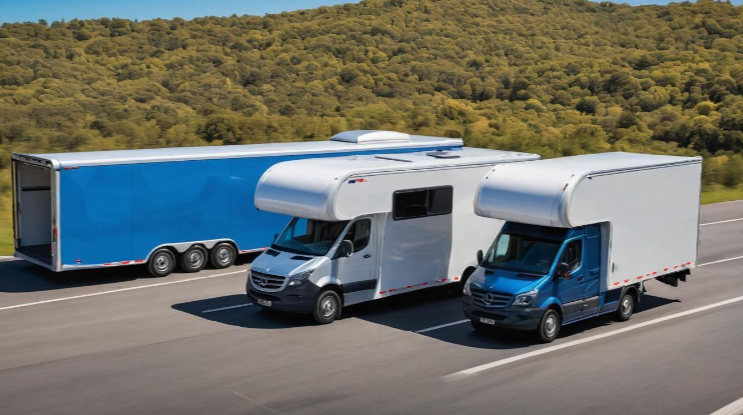Enclosed vs. Open Car Transport Services: A Complete Comparison of Pros and Cons
When it comes to transporting your vehicle, you might wonder which method offers the best blend of cost, convenience, and protection. With so many options available, it can feel overwhelming to decide between open and closed car transport services. The choice is especially crucial if you’re moving a cherished classic car or a practical daily driver. Having navigated this decision myself while moving across the country, I learned firsthand how important factors like weather exposure and potential damage can be. As we dive into the pros and cons of each method, you’ll discover valuable insights that can help you make a well-informed choice based on what matters most for your vehicle.
When choosing between enclosed and open car transport services, consider the value and type of your vehicle, budget constraints, and the level of protection you desire during transit; for example, luxury or classic vehicles benefit from enclosed transport due to enhanced safety. Additionally, weigh the pros and cons regarding costs, availability, and potential exposure to external elements that come with each shipping method.
Enclosed vs. Open Car Transport
Open transport is one of the most common methods for moving vehicles. It involves loading cars onto an open trailer that can accommodate several vehicles at once—typically anywhere from five to ten. This method shines in terms of convenience and cost-effectiveness, making it a popular choice among everyday consumers looking to transport standard vehicles.
For instance, I recently spoke with a friend who needed to move their SUV across the state. They opted for open transport primarily due to its affordability, and even with some trepidation regarding potential wear and tear, they ended up very satisfied when their vehicle arrived without a scratch.
In fact, according to industry reports, open transport accounts for over 90% of car shipments in the U.S., highlighting just how prevalent this method has become.
However, while open transport is highly efficient, it does expose vehicles to certain risks.
Enclosed Transport
On the other side of the coin lies enclosed transport, which prioritizes protection above all else. This method involves placing vehicles within a fully covered trailer—often accommodating fewer cars than open transport due to space constraints; typically around two to six vehicles fit comfortably inside. Picture this: your prized classic car snugly situated within a secure environment where no road debris or harsh weather can reach it. It’s hard not to feel reassured by the sight of those heavy-duty doors locking in your vehicle’s safety.
While the price tag for enclosed transport is notably higher than its open counterpart, the peace of mind it provides can be worth every penny—especially for high-value vehicles like luxury cars or classics that might require extra care during transit. Not only do you gain insulation from external elements, but this mode of transport significantly reduces theft risk as well, offering another layer of security that many buyers find invaluable.
Comparison of Enclosed vs. Open Car Transport:
| Feature | Enclosed Transport | Open Transport |
| Protection Level | High | Moderate to Low |
| Cost | Higher | Lower |
| Capacity | 2-6 vehicles | Up to 10 vehicles |
| Availability | Limited | Widely Available |
| Ideal for Vehicle Type | Luxury, Classics | Standard, Economy |
With these aspects in mind, assessing your preferences and requirements will guide your decision on the most suitable transportation option based on your vehicle type and desired level of care.
Key Differences Between Enclosed and Open Transport
Several factors differentiate enclosed and open transport, each with its unique benefits and drawbacks. One critical difference is the level of protection offered.
Enclosed transport provides a shielded environment that ensures your vehicle remains safe from external elements like rain, snow, and road debris during transit. This is particularly vital for high-value cars—think sleek luxury sedans or classic vehicles that deserve to be well-protected.
Conversely, open transport leaves vehicles exposed to the whims of nature, making it a more cost-effective option but with associated risks such as potential scratches or fading due to UV exposure.
Cost Considerations
When it comes to selecting a transport method, cost is a significant consideration. Enclosed transport can be 50-60% pricier than open transport. This is largely due to enhanced protective measures, specialized equipment, and the fact that enclosed carriers typically accommodate fewer vehicles at once.
For instance, while shipping a standard car cross-country may cost around $1,000 with an open carrier, you might see those costs leap to approximately $1,600 or more when utilizing enclosed transport.
The increase in price often reflects the peace of mind provided by the added safeguards during transit.
Beyond costs, it’s essential to consider which types of vehicles each method is compatible with.
Vehicle Compatibility
Luxury, vintage, or modified vehicles significantly benefit from the additional protection that enclosed transport provides. The investment in an enclosed service can be well worth it for owners of classic cars or high-end models who want to avoid any risk of damage.
On the other hand, if you’re transporting standard or economy cars—vehicles that are less susceptible to minor cosmetic damages—opting for open transport may save you money without compromising the integrity of your vehicle.
Weighing these key differences grants clarity on the advantages each transport method offers. It allows vehicle owners to align their choices with their specific needs and financial situations while ensuring their prized possessions are transported safely and efficiently.
As we explore further into this topic, understanding the specific perks associated with the more protective shipping option can help clarify why some drivers opt for it over others.
Advantages of Enclosed Car Transport
One of the most significant advantages of enclosed car transport is the unparalleled protection it offers. When shipping a vehicle in an enclosed carrier, you shield your automobile from harsh weather conditions like rain, snow, ice, and direct sunlight. This protection is critical, especially for classic cars or luxury models that may have paint finishes susceptible to damage from environmental factors. Imagine having your prized possession transported without the worry of water spots after a heavy rain or scratches from flying debris on the road. This level of care helps maintain both the aesthetic appeal and resale value of your vehicle.
In fact, consider the experience of John D., a dedicated car enthusiast who ensures his vintage collection is shipped in enclosed carriers each year. He stated, “Opting for enclosed transport ensures my cars arrive in pristine condition without a scratch. The peace of mind is worth the extra cost.” His story resonates with many who want their vehicles treated with similar respect and care during transit.
Beyond just weather protection, there’s an essential layer of security provided by enclosed transport that cannot be overlooked.
Enclosed carriers are inherently more secure than their open counterparts. With solid walls surrounding the vehicle and often equipped with locks, these trailers deter potential thieves and reduce the likelihood of vandalism during transport. When transporting high-end or collectible vehicles, this security can be crucial—owners deserve assurance that their investments are safeguarded throughout the journey. While some may argue that comprehensive insurance could lessen the risk associated with theft, opting for enclosed transport inherently provides a quick and uncomplicated means to enhance vehicle security.
Moreover, statistics reveal that vehicles transported in enclosed carriers experience lower instances of theft compared to open transport. Reports indicate theft rates can be as low as 0.5% for enclosed shipments versus around 2% for open transport. This stark difference highlights how taking additional precautions can lead to substantial peace of mind for car owners.
Additionally, the aspect of insurance coverage plays a pivotal role when considering enclosed transport services.
Many enclosed transport companies offer higher insurance limits than those typically available through open shipping methods. Clients can expect coverage levels reaching up to $1 million in many cases because the risk factors are significantly minimized due to secure storage within an enclosed trailer. Conversely, open carrier options generally offer lower maximums—often only around $100,000—which may leave owners feeling vulnerable if unfortunate damages occur during transit.
Cost Consideration
It’s vital to note that while closed transport comes with enhanced protection, it also brings increased costs—averaging between $1,000 and $2,000—compared to open transport’s more budget-friendly price range of $500 to $1,000. Therefore, individuals must weigh their options carefully, balancing the cost against the level of protection required based on their specific vehicle’s value and condition.
If you plan to ship a classic car or any high-value automobile that holds sentimental value, investing in an enclosed carrier might save you from potential heartbreak down the line due to avoidable damage or loss. Prioritizing thorough research into reliable transport companies specializing in enclosed shipping will ensure you’re making the smartest choice for your prized possession.
All these factors contribute to creating a comprehensive understanding of how different transportation methods serve various needs—each tailored to meet unique expectations regarding vehicle safety. Now let’s explore what makes one option particularly appealing for those who value speed and affordability.
Benefits of Open Car Transport
One of the standout benefits of open car transport is its affordability. The sheer efficiency of this method allows carriers to load multiple vehicles onto one truck, effectively distributing transportation costs among several customers. This cost-sharing principle means you can find more budget-friendly rates compared to enclosed transport services.
For instance, transporting a vehicle across the country, say from New York to California, may cost as little as $800 using an open carrier. In contrast, opting for an enclosed carrier could easily push the price above $1,400 due to the added protection and limited capacity.
In addition to being budget-friendly, open transport is often more readily available than its enclosed counterpart.
When it comes to availability and flexibility, open transport services truly shine. With around 80% of car transport companies offering open transport options, they become a common choice among consumers. This widespread availability means shorter wait times for pick-ups and deliveries—a crucial factor if time is of the essence for you.
Imagine you’re moving across the country and need your vehicle at your new home quickly; choosing open car transport can help you avoid long lead times that can sometimes accompany enclosed options.
- Cost-effective: You save money without sacrificing too much in terms of quality.
- Shorter wait times: Get your vehicle shipped faster.
- Widely available: Easier to find a carrier when you need one.
Now that we’ve looked at specific benefits, let’s consider how to choose between the two methods based on different factors.
Each option has its own strengths, particularly when looking at budget constraints and rapid service, making open car transport a compelling choice for those shipping their vehicles safely and efficiently.
As we explore further, it’s essential to evaluate various aspects that can influence your decision-making process in vehicle transport.
Factors to Consider for Each Method
The value of your vehicle is one of the most significant factors to consider when deciding on a transport method. If your car is luxury, classic, or holds sentimental value—such as a family heirloom—opting for enclosed transport can be worth every penny of the higher cost. This method offers enhanced protection from environmental hazards, road debris, and potential theft. Imagine driving a vintage convertible that has been in your family for generations. You would likely want it in a safe cocoon during its journey, rather than exposed to the elements and other unforeseen risks that could diminish its value.
Interestingly, statistics reveal that approximately 70% of luxury car owners prefer enclosed transport compared to just 10% among those with economy cars. This trend underscores the importance of safeguarding high-value assets.
Another element worthy of consideration is the vehicle’s condition upon arrival.
Next, think about the shipping distance and lead time. For shorter distances, the risks associated with open transport might be manageable. However, if you’re moving across several states or coast-to-coast, the exposure duration significantly increases. The longer your car spends on an open carrier, the more susceptible it becomes to potential damage from weather or flying debris. In such cases, switching to enclosed transport is typically a smarter move.
For example, Ashley P., who recently relocated from Florida to California, initially opted for open transport for her everyday sedan. While she found this service timely and her car arrived in acceptable condition—albeit with minimal dust buildup—she acknowledged that had she been shipping a more valuable vehicle, her choice would have been different.
In addition to value and distance, it’s crucial to evaluate lead times and availability when making your decision.
Enclosed carriers may take longer due to limited availability of specialized equipment necessary for loading and unloading vehicles. Therefore, if you’re working with tight timelines—like a planned relocation—you’ll need to consider how dispatching an enclosed carrier can affect overall logistics and timing.
As we weigh these considerations carefully, understanding how they impact your unique situation can lead you toward making enlightened choices about vehicle transportation options.
Making an Informed Decision
When it comes to vehicle transport, making an informed decision is about more than just cost—it’s about aligning your choice with your values and priorities. First and foremost, think deeply about what matters most to you in this transport experience.
Consider the value of your vehicle: If you’re shipping a high-end sports car or a family heirloom, the stakes are different than if you’re transporting a standard sedan.
Reflect on what you’ll prioritize: Will potential cosmetic damage from environmental exposure be acceptable? Or do you seek maximum protection at all costs? Recognizing these factors will lead you closer to the right choice for your transport service.
Next comes the urgency of delivery. If you’re in a hurry, open transport may be the better choice due to its quicker availability and shorter transit times. On the flip side, if you’re less pressed for time and can invest in peace of mind, an enclosed option provides optimal security. It’s worth noting that enclosed transport services typically take longer because they accommodate fewer vehicles.
Beyond your personal preferences, reviewing feedback from other consumers can be incredibly beneficial.
Consult Reviews and Experts
Have you ever wished you had insider knowledge before making a purchase? Well, when it comes to selecting a car transport service, tapping into others’ experiences might just provide that advantage. Scouring reviews on platforms like Trustpilot or Consumer Affairs can shed light on how certain companies handle their responsibilities and the quality of their service.
Look for patterns in feedback: Are customers frequently praising quick delivery times? Do they mention any negative experiences? By aggregating this information, you gain valuable insights into the reliability of your prospective transportation company.
According to recent data, around 73% of consumers read reviews before making a purchase decision, highlighting the importance of taking this step seriously.
Consulting with industry experts can also clarify uncertainties. Reach out to transport companies directly and ask them specific questions regarding their shipping methods. A reputable company should not only be transparent about their processes but also willing to share customer testimonials.
After evaluating both online insights as well as expert opinions on services available, you’ll be better equipped to move forward confidently.
Final Thoughts
Ultimately, there isn’t a one-size-fits-all answer in choosing between enclosed and open car transport. What works best for one person might not apply to another; discerning factors include budget constraints, vehicle value, urgency of shipping, and personal comfort with risk.
By acting thoughtfully through this comprehensive analysis, you’re positioning yourself to make an informed decision that aligns with your specific transport requirements while safeguarding your investment.
In summary, weighing your options carefully based on personal preferences and consumer feedback will lead you to the best decision for your vehicle’s transport needs. Prioritize what matters most to ensure a satisfactory experience.






